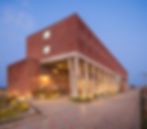The Rise of the Second Skin
- Sachin Rastogi, Founding Director and Principal
- Jan 25, 2021
- 2 min read
Updated: Feb 25, 2021
In the past, the trend of the single skin facade—designed with a single-layered envelope of a permanent material such as glass, has dominated the skyline of most cityscapes. While modernist in appeal, such glass enclosures act as solariums that trap heat, adding to mechanical ventilation and cooling loads. Further, the generic wall-window elevation does not do much aesthetically and the paint and plaster treatments on the walls require maintenance and are not permanent solutions. Hence, looking at the second skin as a solution is becoming the most relevant and favoured alternative for architects in India.

In hot and humid countries, like India, the double-skin façade needs to respond to the climatic context through vernacular design. If we think about it, our country’s architecture has for centuries employed climatic responsive design for energy efficiency. We see the use of elements such as jaalis (latticed screens), chajjas (sloping eaves and canopies) and jharokhas (overhanging balconies), particularly in India’s northern regions addressed needs for lighting and ventilation while protecting occupants from harsh sunlight. While double skin systems in the West employ a double-glazed unit with an insulation layer in between, such a solution will be of no value in the Indian context.

Within the Indian context, the outer skin should be designed as a semi-permeable layer such as a jaali to help in shading and regulate the temperature between the exterior and interior environments via a controlled airflow. In this sense, this first skin becomes a transition zone on the vertical plane and creates an intermediate micro-climate of its own. The role of the second skin, then, should be to provide a volume where the user can step out of from the interiors to a shaded environment such as a balcony or court but is a space which prioritizes thermal comfort through the adaptive behaviour of the building and enables functionality. The second skin takes on the role of a breakout space between the interior and exterior. It empowers occupants to take charge of their environment and sustainability as well as connect with nature while still being inside the building.

Photography: Noughts and Crosses | Andre J. Fanthome



